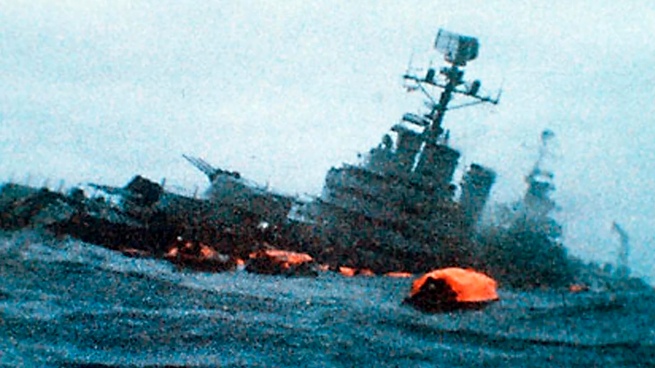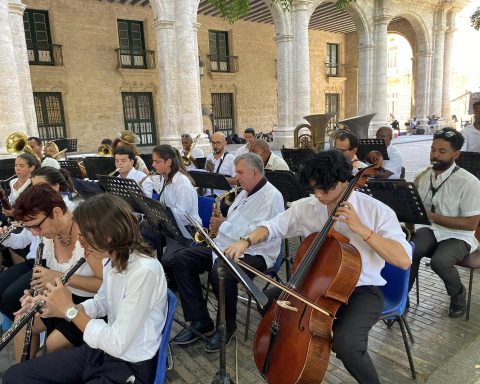On May 2, 1982, just after 4:00 p.m., the conscript sailor George Massin walked to the position assigned to him as part of the crew the 6th Artillery Division of the General Belgrano Cruiserthe six-inch cannon of turret 1, when in the middle of the changing of the guard he felt an explosion followed by another that, as he recalled in dialogue with Télam 40 years later, “took the 13,000-ton ship launched at 2 out of the water.” ° World War.
The ship would sink in 40 minutes, with a result of 323 dead.
massin survived.
Assuming oneself as one of the 770 crew members who can count the attack by the submarine “Conqueror” left its marks on this resident of the Santa Fe town of Avellaneda, a son of the gringa pampas who had not known the sea until 1982 and who after the war had not traveled further south from Punta Alta.

For Massin, the colimba’s experience as a class of 1962 began with number 937, which decided its incorporation into the Navy and allowed him to discover the sea, Cape Horn and travel the Beagle Channel six times, after 56 days of training at the Sarmiento training camp to become a “cannoneer” of anti-aircraft artillery and naval combat.

The attack outside the exclusion area
On May 1, 1982, the 1,093 crew members of the cruiser General Belgrano -among them the cruiser from Santa Fe- received orders to patrol the waters south of Malvinas together with the destroyers Piedrabuena and Bouchard.: Navigation in that area was outside the 200-mile military exclusion zone radio set unilaterally by the UK.
At 4 pm on May 2, with the impact of the first torpedo, Massin felt through his body how the explosion pierced the darkness. -because the power went out immediately- while the expansive wave seemed to lift the boat and its legs bent under the pressure that pushed upwards.
“It was like something was falling in the air, and when that fall ended, the other torpedo went in and the ship started to rise back up. The explosion was so serious and so strong because the first torpedo hit the engine room and the The explosion opened all the doors of the cruise ship. For this reason, it was impossible to do damage control, close accesses and divide into watertight behaviors”, explained the sailor with the jargon that he never forgot.
After the second torpedo, the crew that was in a position to carry out orders started the practice that they would never have wanted to apply, the abandon ship parade.
First, fuel tanks had to be thrown into the water to prevent a fire; then arrange the more than sixty rafts at full speed to abandon the ship before the sinking of it.
“The guard who was sleeping upstairs, plus those who were on duty in the engine room, all of them died,” Massin recounted about those defining minutes that separated the lives of the 770 crew members who managed to survive from the other third of the ship, which he could not do anything when he was in his orlodos (cabins) or at the place of the detonation.
As the ship had lost electrical power, the officers could not use the signal system and had to give orders by megaphone.
Massin contributed his view of a debate that still rages over the “Conqueror” submarine attack: was the torpedoing outside the exclusion zone an act of war or a war crime?
However, this possibility had been rehearsed in the practices, the conscript from Santa Fe revived, “they even cut off the electricity and we had to get to the assigned post somehow, in the dark.”

For those who were in the heart of the ship, the key was to get out between the first and second explosion: “Of those who were going down the stairs, two already suffered burns and barely managed to get out. The one who didn’t get out at that time, couldn’t get out anymore,” reconstructed the crew member who was assigned to turret 1.
survive on the raft
The fight for survival had only just begun.
Massin relived the simultaneous action of 770 people to save themselves and attributed the number of survivors to the repetition of the training, to the will to live of each one and “to the force of adrenaline, which at that moment does not let you think”.
“Once on the rafts, we had a storm on top with waves of between 6 and 8 meters, with a wind of 100 kilometers per hour. When the wind overwhelmed the wave, if those of us who were on the raft did not fight against the wave and jump everyone to the opposite side, the raft could turn over. If that happened, automatically, we had three minutes left to live, “explained the sailor.
On the raft that Massin climbed on, the arm wrestling with the waves lasted 36 hours. From May 2 at 4:00 p.m. to May 4 at 5:30 a.m., when the ship Bouchard rescued them. The “gunner” of turret 1 shared the trance with several crew members, including the commander of the torpedoed cruiser, Captain Héctor Bonzo, who died fifteen years ago as a result of a heart attack.
“The commander always seemed to me a good guy within the military career, one of those who honor the uniform. Years later, in some meetings in Buenos Aires, he gave me a book about what we had lived through. But I never read it. Never. I still have it saved as a very important memory. I hope one day I can read it,” he said.

After the testimony about the event that defined his life, Massin contributed his perspective on a debate that still rages over the attack on the “Conqueror” submarine: the torpedoing outside the exclusion zone, was it an act of war or a war crime?
While for the former head of the Army, Martín Balza, the British attack occurred in international waters against a target that could “negatively affect” the United Kingdom forces, so it must be framed in an act of war contemplated by chapter seven of the Charter of the United Nations, for Massin “it was a war crime, because they (the British) did not respect the rules that they themselves set”.
“They put a rule about the exclusion zone and they broke it themselves. Also, they knew it was an American ship from World War II: they knew in detail the risk to the victim they had chosen, they knew the ship. They were clear, They were looking to give a lunge so that Argentina would withdraw and leave the Malvinas,” he considered.
Massin never returned to the southernmost part of the continent, nor was he in the Malvinas.
Télam asked him if he would like to see the islands: “I would like to go one day, but doing it without a passport, I don’t know if it’s clear what I mean”he just answered.

The cruiser General Belgrano, launched in 1938 as “Phoenix” and which in 1941 emerged unscathed from the Japanese attack on Pearl Harbour, sank on May 2, 1982, at approximately 5:00 p.m., in Los Yaganes, a basin south of the Malvinas which is 4200 meters deep.


















